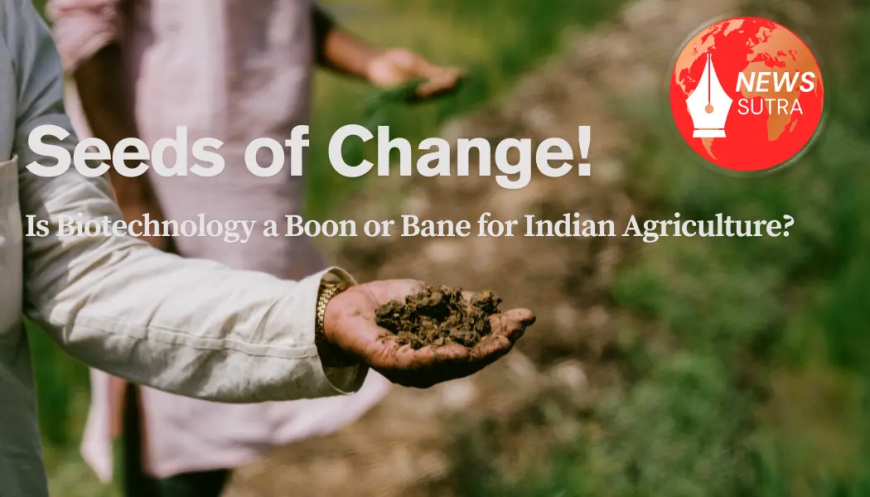Seeds of Change: Is Biotechnology a Boon or Bane for Indian Agriculture?
Biotechnology in Indian agriculture promises higher yields and pest resistance, but also raises ethical, ecological, and economic concerns. Is it truly a boon or potential bane?

In a country where agriculture employs over 40% of the workforce and feeds more than a billion people, innovations that promise better yields, resistance to pests, and climate resilience are naturally welcome. Biotechnology is one such innovation that has divided opinion across India’s farmlands, policy circles, and environmental forums.
With technologies like genetically modified (GM) crops, Bt cotton, and CRISPR gene editing, biotechnology is steadily altering how food is grown. But for every promise of prosperity, there’s also concern about biosafety, monopolistic control, and long-term soil health.
So, is biotechnology a boon or bane for Indian agriculture? Let’s explore the full picture.
1. What Is Agricultural Biotechnology?
Biotechnology in agriculture involves using scientific techniques such as genetic engineering, molecular markers, and tissue culture to modify crops for specific traits. This includes:
-
Increased yield potential
-
Pest and disease resistance
-
Drought and salinity tolerance
-
Improved nutritional content
The Indian Council of Agricultural Research (ICAR) has been actively involved in promoting biotechnological interventions for over two decades, especially under the National Agricultural Biotechnology Strategy 2022–2027.
2. Bt Cotton: A Case Study in Mixed Outcomes
India’s first and only commercially approved GM crop—Bt cotton—was introduced in 2002. Engineered with a gene from the bacterium Bacillus thuringiensis, Bt cotton is resistant to bollworm, a major pest for cotton growers.
Positive Outcomes:
-
Yields increased by up to 30% in the early years, according to a study by the International Food Policy Research Institute (IFPRI).
-
Farmers initially experienced reduced pesticide use, lowering costs and health risks.
Negative Fallout:
-
Over time, bollworm resistance to Bt cotton emerged, forcing farmers to resume pesticide use.
-
High seed costs and dependence on a few biotech companies—notably Monsanto (now part of Bayer)—raised fears of corporate control over farming.
-
Farmer debt and suicides in regions like Vidarbha were controversially linked to Bt cotton, though researchers debate the correlation.
3. The Regulatory Landscape: A Cautious Approach
India’s regulatory structure is deliberately cautious when it comes to GM crops:
-
The Genetic Engineering Appraisal Committee (GEAC) under the Ministry of Environment, Forest and Climate Change is the apex body for approval.
-
Only Bt cotton has been approved for commercial cultivation. Trials for GM mustard (DMH-11) have faced stiff opposition.
The government’s stance is balanced but slow-moving. According to a 2023 report by NITI Aayog, biotechnology can aid food security but must be carefully monitored for biosafety and environmental risks.
4. Emerging Frontiers: Beyond GM Crops
Modern biotechnology is evolving beyond first-generation GMOs:
-
CRISPR Gene Editing: India has begun trials for CRISPR-based crops, which can modify plant DNA without inserting foreign genes. The Department of Biotechnology (DBT) is backing this through public-private partnerships.
-
RNA Interference (RNAi) Technology: Used to silence genes in pests rather than alter plant DNA—showing promise for crops like rice and brinjal.
-
Biopesticides and Biofertilizers: Not all biotech is gene-based. India is witnessing a rise in microbial fertilizers and eco-friendly pesticides, championed by startups like AgBiTech and government-supported bio-innovation clusters.
5. Who Benefits from Agricultural Biotechnology?
Farmers:
-
Large farmers with access to credit, irrigation, and modern tools gain significantly from biotech crops.
-
Smallholders, however, often lack information or financial capacity to invest in biotech seeds or required inputs.
Consumers:
-
Potential for nutrient-enriched foods (e.g., Golden Rice, GM mustard with higher omega-3s) exists, but public skepticism delays rollout.
Industry:
-
Agritech companies like Mahyco, Rasi Seeds, and Bayer India benefit from seed patents and high-value crop segments.
6. Environmental and Ethical Concerns
Not all that glitters in biotech is green:
-
Biodiversity Loss: Monocultures of biotech crops can reduce crop diversity and resilience.
-
Soil Health Degradation: Long-term impacts of modified root exudates and chemical dependencies are not fully understood.
-
Pollination Risks: Cross-pollination with native varieties could have unknown consequences.
-
Intellectual Property Conflicts: Seed-saving traditions are at odds with patents held by multinational firms.
Activist groups like Navdanya argue that India’s agroecological traditions are being undermined by “seed imperialism.”
7. Global Lessons for India
India isn’t alone in grappling with biotech dilemmas. Countries like Brazil, USA, and China have embraced GM crops widely, reporting productivity gains—but not without ecosystem stress.
In contrast, European nations have adopted the precautionary principle, maintaining strict bans or moratoriums.
India’s dual-track approach—encouraging research but slow on approvals—may seem bureaucratic, but it reflects a legitimate balancing act.
8. The Path Forward: Coexistence, Not Conflict
To make biotechnology truly work for Indian agriculture:
-
Transparent Regulation: Independent safety studies and public access to trial data are essential to build trust.
-
Farmer Training: Biotech without agro-literacy often backfires. Programs like Kisan Call Centres should integrate biotech modules.
-
Seed Diversity Protection: GM crops should not replace but complement native varieties.
-
Public Sector R&D: More funding to public biotech labs will reduce over-reliance on private seed firms.
Conclusion: A Conditional Boon
Biotechnology in Indian agriculture is neither a clear boon nor an outright bane—it is a powerful tool whose impact depends entirely on how it’s used.
With proper checks, community engagement, and ethical regulation, biotechnology could boost yields, withstand climate stress, and enhance nutrition. But without these, it risks deepening inequalities and ecological harm.
As India prepares for the next agricultural revolution, the real question is not whether biotech is good or bad—but whether we’re governing it wisely enough.
What's Your Reaction?
 Like
0
Like
0
 Dislike
0
Dislike
0
 Love
0
Love
0
 Funny
0
Funny
0
 Angry
0
Angry
0
 Sad
0
Sad
0
 Wow
0
Wow
0









































